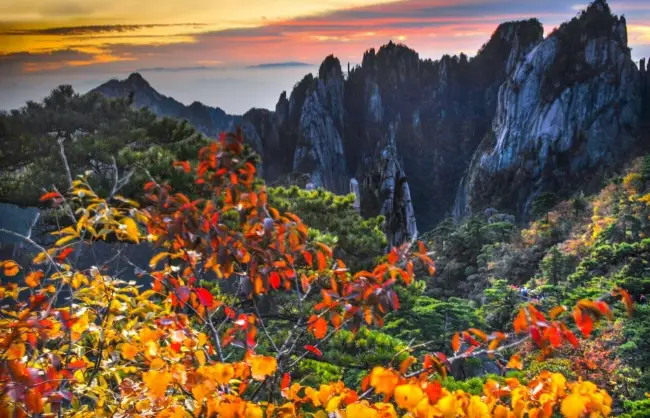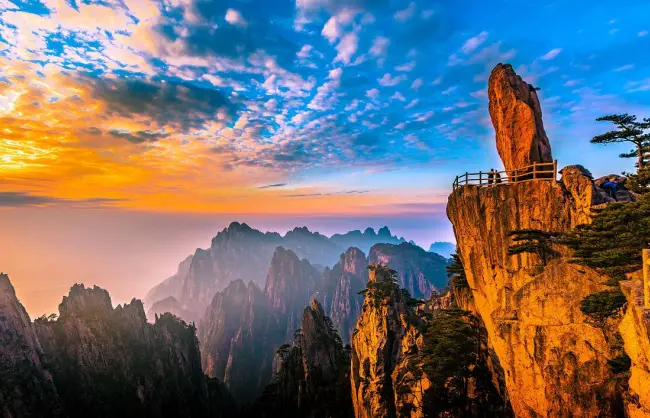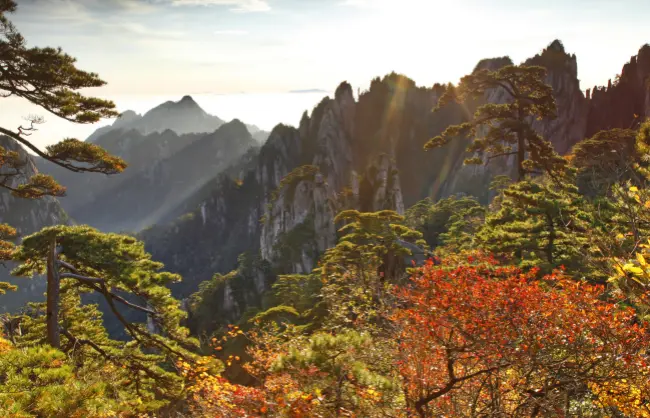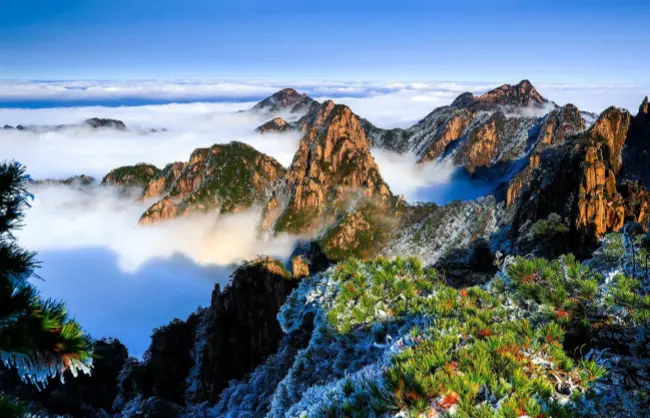Standing on the peaks of Huangshan Mountain in autumn, you’ll struck breathless by the spectacular mountainous landscapes. As the “Number One Marvelous Mountain Under Heaven”, the Yellow Mountain gradually transforms into a palette of golden, orange, and green hues from mid-September to November each year. It will refresh all your imagination of autumn, with its colorful autumn foliage, and picturesque scenery composed of seas of clouds, peculiar pines, and unique rock formations.
If you travel to China in autumn, visiting the legendary Huangshan Mountain should be a can’t miss. Accompanied by the comfortable temperatures, you can hike along the scenic trails, gaze into the distance from a high vantage point, and marvel at the mountain in a hidden “paradise mode” for photography enthusiasts.
For people who are interested in Huizhou culture, it is advised to visit some of local villages after their Huangshan Mountain tour. As autumn is the time when these villages are decorated with colorful leaves of ancient trees, golden rice fields, and the picturesque scene of traditional “Shaiqiu”.
In this guide, we’ll equip you with all information and knowledge you need to know to travel to Huangshan Mountain in autumn, including its autumn weather, packing and wearing tips, top autumn sceneries, and insider’s tips and advice.

Huangshan Weather in Autumn (September, October, November)
Autumn at Huangshan Mountain, typically spanning from early September to late November, offers some of the most vibrant colors and pleasant weather of the year. With temperatures gradually decreasing, foliage begin to turn yellow in September (early autumn in Huangshan). Then, in late autumn (mid-October to November), after the temperatures experience a significant drop, the red leaves reach their peak. In the late November, visitors can even encounter frost at the mountain top.
Besides the decreasing temperatures, Huangshan Mountain in autumn also features large day-night temperature differences, which can reach 10-15°C. And the temperature difference between the base and summit (around 1,800 meters in elevation) is about 8-10°C.
After the rainy season in summer in Huangshan, autumn sees a relatively dry weather condition, with the rainfall probability gradually decreasing from September to November.
Overview of Temperatures & Rainfall in Huangshan in Autumn
| Month | September | October | November |
| Average Temperature at Mountain Base (°C) | 16-25 | 12-22 | 4-15 |
| Average Temperature at Mountain Summit (°C) | 11.3-16.7 | 6.5-12.6 | 1.2-7.9 |
| Average Monthly Precipitation (mm) | 174 | 102 | 87 |
| Rainy Days Frequency | 12 | 8 | 6 |
What to Wear & Pack in Huangshan in Autumn
Clothing Guide
Due to the significant temperature differences between day and night, and the mountain base and summit, it is advisable to wear layers for flexible adaptation.
- Base layer: Quick-dry long-sleeve T-shirt, breathable sports underwear
- Mid layer: Fleece, light down jacket, wool sweater
- Outer layer: Windproof and waterproof jacket (with hood), softshell pants
- Spare clothes: Thick down jacket (essential in November), warm hat, gloves (windproof, touch-screen compatible).
- Footwear: Non-slip hiking boots, quick-dry thick socks
Monthly clothing recommendations:
- September: Quick-dry T-shirt, fleece, and jacket for daytime, add light down jacket on the summit at night.
- October: Fleece/sweater + down jacket/windproof jacket, gloves
- November: Thick down jacket + thermal pants + warm hat, gloves with fleece
Other Essential Items
- A walking stick is essential, even if you use the cable car up and down.
- Bring some common medication, such as motion sickness tablets, cold medicine, digestive remedies, band-aids, and mosquito repellent (especially important in September).
- Sun protection: Sunscreen (SPF 50+), sunglasses (necessary on clear days).
- Snacks and water: Food options on the mountain could be limited, so prepare some energy-boosting snacks. Carry your water bottle, and there are places to refill.
- Backpack: Carry snacks, water, and other personal items.
- Cash: Have 100-200 RMB in cash. Due to the poor signal on the mountain, some small shops may not accept mobile payment.
- Portable charger: Use your phone for photos can quickly drain the battery.

What to See in Huangshan in Autumn
Classic Scenic Spots of Huangshan Mountain
Most of the classic scenic spots on Huangshan Mountain are open to visitors in autumn, except for Tiandu Peak and Lotus Peak. These two peaks follow a five-year rest cycle for ecological protection. (Tiandu Peak reopened in 2024, while Lotus Peak is currently in its resting phase).
Most attractions show their best beauty in autumn. Following a well-organized route, you can enjoy the 360° panoramic view of the cloud sea and sunrise from the Bright Summit, the red leaf corridors and peak forests of the West Sea Grand Canyon. From the Paiyun Pavilion, you can admire the golden glow over the West Sea Grand Canyon. The iconic Beginning-to-believe Peak is more stunning when decorated with the unique pine trees and autumn hues…
The Yellow Mountain is ready to welcome visitors with the perfect fusion of its “Four Wonders” with the colorful foliage in autumn.
Sunrises and Sunsets in Autumn
The sunrises and sunsets are both highlights of Huangshan’s autumn. As the air is clear in this period, the reduced moisture in the air allows light penetrates more deeply, resulting more striking sceneries than other seasons. What’s more, the colorful autumn foliage add another layer of color to the landscape, largely enhancing the already breathtaking views.
Sunrise and Sunset Times at Huangshan:
- September: Sunrise around 5:40-6:00 AM, Sunset around 6:10-6:30 PM
- October: Sunrise around 6:00-6:20 AM, Sunset around 5:30-5:50 PM
- November: Sunrise around 6:20-6:40 AM, Sunset around 5:00-5:20 PM
Good to know: The exact time may vary slightly each day. And it is recommended to arrive at the viewing platform about 30 minutes to 1 hour early.
Best Spots for Sunrise and Sunset Viewing:
- Sunrise: Bright Summit (360° panoramic view, more crowded), Beginning-to-Believe Peak (a 20-minute walk from Beihai Hotel), Danxia Peak (lesser crowded, offer great view of the West Sea Grand Canyon).
- Sunset: Paiyun Pavilion (offer a golden glow over the West Sea Grand Canyon), Flying Stone (the surrounding mountains are decorated with yellow leaves in autumn), Aoyu Peak (Offers eastward views of Lotus Peak, and westward views of Bright Summit).

Autumn Foliage at Huangshan Mountain
As one of the most iconic sights in East China, Huangshan’s autumn foliage features vivid colors and beautiful coexistence with the dramatic peaks and mystical seas of clouds.
Red-leaved trees on Huangshan Mountain are mainly sweetgum, Chinese sweetgum, Hangshan rowan, and mountain pepper. From September to November, the leaves will gradually change from green to shades of golden yellow, orange-red, and deep crimson, creating a mesmerizing display.
Best viewing spots for autumn foliage:
West Sea Grand Canyon (autumn colors meet rugged peaks), North Sea Scenic Area (ancient pines and red leaves), Yuping Scenic Area (iconic pine trees complemented by a backdrop of red leaves and peaks), Hot Spring Scenic Area (an autumn paradise at lower elevations).
Sea of Clouds in Autumn
Thanks to the the significant temperature difference between day and night, Huangshan’s autumn, especially from late October to November, is a period seeing relatively frequent sea of clouds.The combination of the sea of clouds, autumn foliage, and the interplay of light and shadow in this season creates an unparalleled natural spectacle. The cloud sea usually show multiple layers as the air of autumn is dry and clear.
Key areas to view the sea of clouds in autumn: East Sea (White Goose Ridge, Gongyang Mountain), West Sea Grand Canyon (Paiyun Pavilion, Danxia Peak), South Sea (Yuping Lou, Tiandu Peak), North Sea (Lion Peak, Qingliang Terrace), Tianhai (Bright Summit, Auyu Peak)

Autumn Colors in Ancient Villages near Huangshan Mountain
Not only the Yellow Mountains, the ancient Hui-style villages in Huangshan also offer their most vibrant scenery in autumn. Classic villages, like Hongcun, Xidi, Tachuan, and Chengkan, are decorated by red lanterns, yellow chrysanthemums, the vibrant red leaves of ancient trees, and surrounding golden rice fields. The vibrant colors blend seamlessly with the white walls and dark roofs of elegant Hui architecture, creating an ink-wash painting effect.
What’s more, autumn is also the time you can witness the unique and beautiful “Shaiqiu” in these villages. Shaiqiu is a local rural tradition, meaning drying crops in autumn. In this period, local villagers like to dry crops of different colors, like peppers, corn, and chrysanthemums, on their drying yards or the roofs of the residences. Each year, there are many visitors get to these Huizhou villages to capture this rustic charm.
Related Reading:
Best Huangshan Tours
- Huangshan Day Tour With Round Way Cable Car
- 2 Days Huangshan Private Tour: Yellow Mountain, Hongcun Village
- 3 Days Huangshan Private Tour with Local Village
- 3 Days Mount Huangshan Hiking Tour
Ultimate Huangshan Mountain Autumn Travel Tips
- When visiting challenging paths, such as the West Sea Grand Canyon or the Hundred Steps Cloud Ladder, it is advisable to wear non-slip hiking shoes for safety.
- It is recommended to avoid the most crowded National Day Holiday (October 1st to 7th). Late October to early November is better, when the autumn foliage is at its peak and there are fewer tourists.
- Due to the large temperature difference between day and night (up to 15°C), a thick down jacket, warm hat, and gloves (necessary in November) are a must at night.
- Huangshan’s major peaks stand over 1800 meters high. To avoid mild dizziness or shortness of breath, it is advisable to take frequent breaks, drink small amounts of water regularly, and avoid hiking on an empty stomach.
- 8:00-10:00 AM is the busiest times for the cable cars. It is a good idea to ascend before 6:30 AM or in the afternoon.
- For a one-day trip on Huangshan Mountain, you’d better take the Yungu or Yuping Cable Car and focus on core areas such as North Sea, West Sea Grand Canyon, and Bright Summit.
- With two days, you can focus on the back mountain (Yungu Temple, Beginning-to-Believe Peak, North Sea) on the first day. Explore the Xihai Grand Canyon and front mountain the next day.
- The early morning after rainfall offers the best chance to see the sea of clouds. You can check the weather forecast on the official website or WeChat Account of the scenic area.
- Snowfall is possible in mid to late November. Please wear simple ice cleats when the paths are icy.









